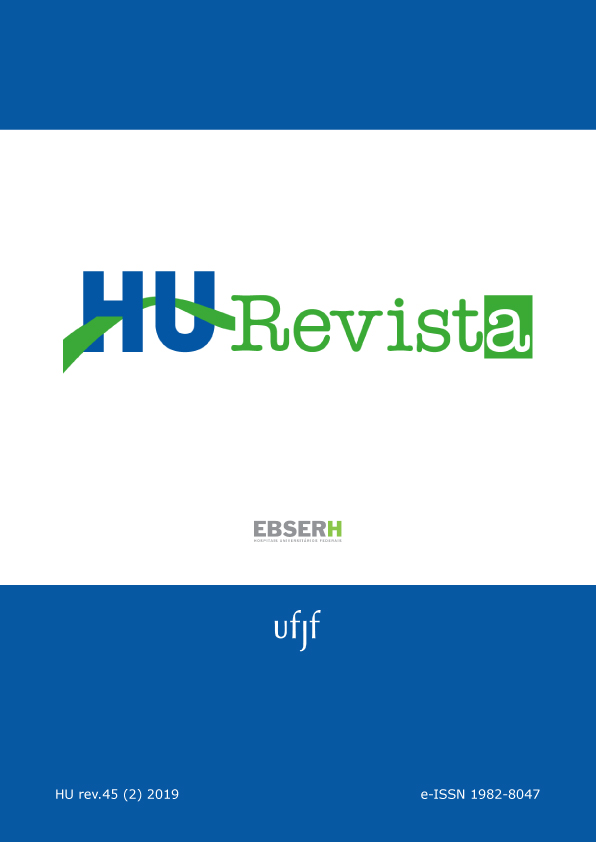Traction of impacted upper central incisor with the aid of a modified transpalatal bar: case report
DOI:
https://doi.org/10.34019/1982-8047.2019.v45.26674Keywords:
Incisor, Tooth Impacted, Tooth Movement TechniquesAbstract
INTRODUCTION: Impacted maxillary central incisor is a challenging condition for dentists, generally requiring a multidisciplinary approach. It can occur due to lack of space in the dental arch, primary or permanent successor dental alterations, presence of supernumerary teeth and/or associated pathological lesions, or due to a dense bony coating and excess local soft tissue. Careful planning and early intervention become essential to minimize esthetic and functional compromises, avoiding negative interference to the patient's psychological and social development. OBJECTIVE: Report a clinical case in pediatric patient related to the impaction of the permanent upper central incisor and its orthodontic traction with the modified transpalatal bar. CASE REPORT: 13-year-old male patient with esthetic discomfort in his smile due to prolonged retention of the deciduous incisor. Imaging exams identified impaction of the permanent incisor and suggestive image of compound odontoma, as well as agenesis of the permanent lateral incisors. In the first moment, an extraction of the deciduous incisor and canines was performed along with the excision of the compound odontoma, while awaiting spontaneous eruption of the permanent incisor. Faced with an incomplete eruption of the permanent incisor during a 6 month period, the incisor traction was opted for with the aid of an orthodontic button and rubber bands supported by a modified transpalatal bar. RESULTS: Patient is found with the central incisor erupted, awaiting fixed orthodontic treatment for correct dental alignment and leveling. CONCLUSION: The modified transpalatal bar is an important component for supporting the wire during the impacted incisor traction in patients unable to use fixed orthodontic appliances.
Downloads
References
Miloro M, Ghali GE, Larsen PE, Waite PD. Princípios de cirurgia bucomaxilofacial de Peterson. 2. ed. São Paulo: Santos;2013.
Pavoni C, Mucedero M, Laganà C, Paoloni V, Cozza P. Impacted maxillary incisors: diagnosis and predictive measurements.
Ann. stomatol.2012; 3(3-4):100-5.
Cozza P, Mucedero M, Ballanti F, De Toffol L. A case of an unerupted maxillary central incisor for indirect trauma localized horizontally on the anterior nasal spine. J. clin. pediatr. dent.2005; 29(3):201-3.
Santos MESM, Silva ARBL, Florêncio AG, Silva UH. Odontoma como fator de retenção dentária: relato de casos clínicos. Rev. cir. traumatol. buco-maxilo-fac. 2010; 10(2):25-30.
Salgado H, Mesquita P. Compound odontoma-case report. Rev. port. estomatol. cir. maxilofac. 2013; 54(3):161-5.
Pacifici A, Carbone D, Marini R, Pacifici L. Surgical management of compound odontoma associated with unerupted tooth.
Case Rep Dent. 2015; 2015(1):1–6.
Kokich VG, Mathews DA. Surgical and orthodontic management of impacted maxillary canines. Am J Orthod Dentofacial Orthop. 2004; 126(3):278-83.
Tan C, Ekambaram M, Yiu CKY. Prevalence, characteristic features, and complications associated with the occurrence of unerupted permanent incisors. PLoS Curr. 2018; 13(6):1-14.
Lu P, Chew MK. Orthodontic-surgical management of an unusual dilacerated maxillary incisor. J Orthod Sci. 2018; 7:24-8.
Maia A, Santos M, Simões F, Rodrigues S, Novaes T, Imparato J. Tracionamento de incisivo central superior permanente impactado pela presença de um mesiodente: relato de caso. RFO. 2015; 20(1):93-100.
Medeiros PJ. Cirurgia dos dentes inclusos: extração e aproveitamento. 1. ed. São Paulo: Santos; 2003.
Hupp JR, Ellis E, Tucker. Cirurgia oral e maxilofacial contemporânea. 6. Ed. São Paulo: Elsevier; 2015.
Bishara, SE. Impacted Maxillary canines: a review. Am J Orthod Dentofacial Orthop. 1992; 101(2):159-71.
Odegaard, J. The treatment of a class I malocclusion with two horizontally impacted maxilary canines. Am J Orthod Dentofacial Orthop. 1997; 11(4):357-65.
Capelozza Filho L, Consolaro A, Cardoso MA, Siqueira DF. Perfuração do esmalte para o tracionamento de caninos: vantagens, desvantagens, descrição da técnica cirúrgica e biomecânica. Dental Press J Orthod. 2011; 16(5):172-205.
Moura WL, Moreira TCA, Teles JBM. Avaliação da resistência à tração de artifícios ortodônticos – braquete, botão e tela – colados em pré-molares com resina autopolimerizável: estudo “in vitro”. R Dental Press OrtodonOrtop Facial. 2004; 9(3):110-5.
Nogueira AS, Farias RD, Luzardo CF, Morandi R, Nogueira LG, Silva FEF. Condutas cirúrgico ortodônticas relacionadas aos caninos inclusos. Ortodontia. 1997; 30(1): 84-92.
Kurol J. Impacted and ankylosed teeth: why, when, and how to intervene. American Am J Orthod Dentofacial Orthop. 2006; 129(4):86-90.
Charpentier V, Makaremi M, Brondeau F. Autotransplantation of a maxillary incisor and orthodontic care: a case study. Orthod Fr. 2017; 88(4):333-41.
Jaiswara C, Srivastava VK, Dhiman N. Autotransplantation of a strange positioned impacted central incisor in a surgically prepared socket: a miracle esthetic concept. Int J Clin Pediatr Dent. 2016; 9(3):269-72.
Cruz M, Silva VC. Movimentação cirúrgica de dentes inclusos: deslocamento controlado. Ortodontia. 1994; 27(1):39-51.
Nolla CM. The development of permanent teeth. J Dent Child. 1960; 27:254-66.
Consolaro A. Tracionamento ortodôntico: possíveis consequências nos caninos superiores e dentes adjacentes: parte 1: reabsorção radicular nos incisivos laterais e pré-molares. Dental press j. orthod. 2010; 15(4):15-23.
Zeno KG, El-Mohtar SJ, Mustapha S, Ghafari JG. Finite element analysis of stresses on adjacent teeth during the traction of palatally impacted canines. Angle Orthod. 2019; 89(3):418-25.
Additional Files
Published
How to Cite
Issue
Section
License
Cessão de Primeira Publicação à HU Revista
Os autores mantém todos os direitos autorais sobre a publicação, sem restrições, e concedem à HU Revista o direito de primeira publicação, com o trabalho licenciado sob a Licença Creative Commons Attribution que permite o compartilhamento irrestrito do trabalho, com reconhecimento da autoria e crédito pela citação de publicação inicial nesta revista, referenciando inclusive seu DOI.









